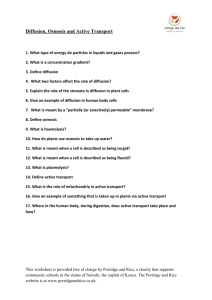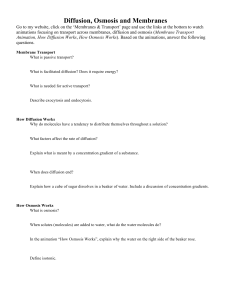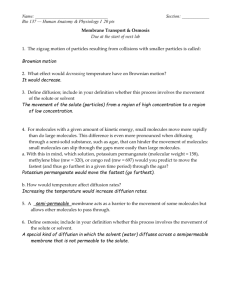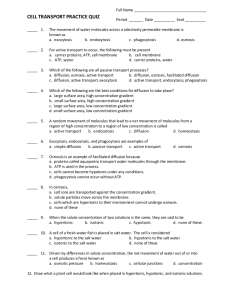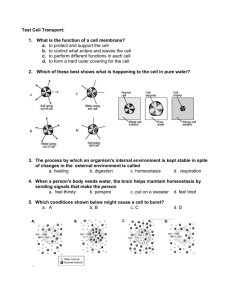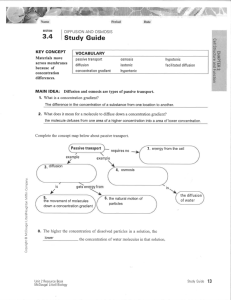FILTRATION, DIFFUSION, AND OSMOSIS
advertisement
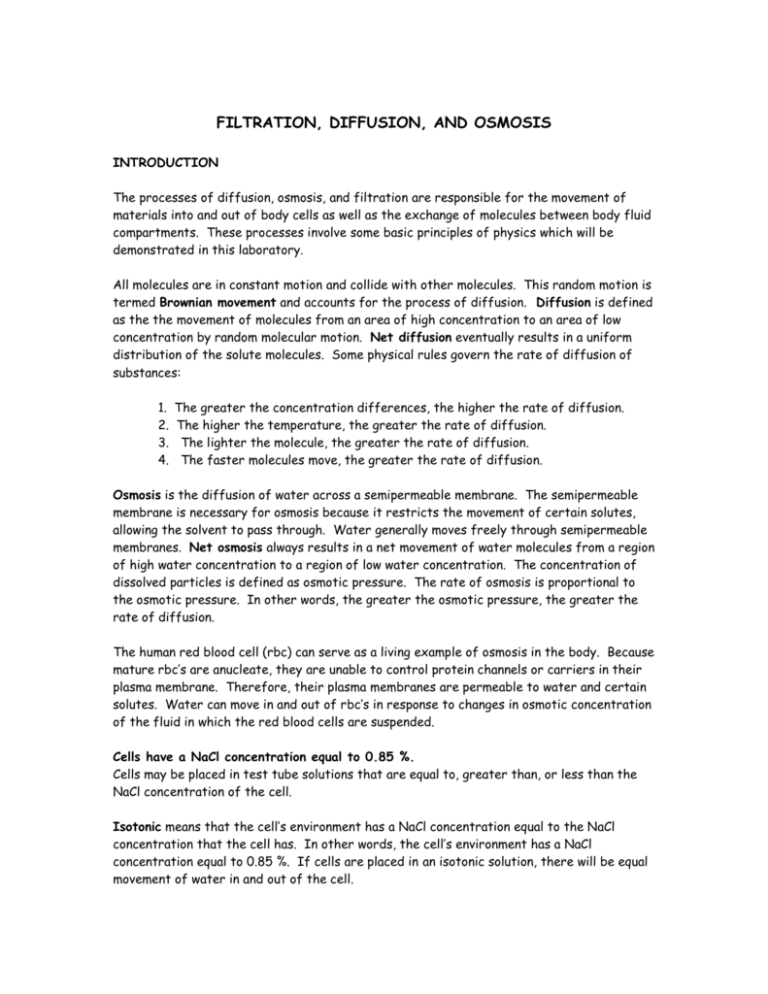
FILTRATION, DIFFUSION, AND OSMOSIS INTRODUCTION The processes of diffusion, osmosis, and filtration are responsible for the movement of materials into and out of body cells as well as the exchange of molecules between body fluid compartments. These processes involve some basic principles of physics which will be demonstrated in this laboratory. All molecules are in constant motion and collide with other molecules. This random motion is termed Brownian movement and accounts for the process of diffusion. Diffusion is defined as the the movement of molecules from an area of high concentration to an area of low concentration by random molecular motion. Net diffusion eventually results in a uniform distribution of the solute molecules. Some physical rules govern the rate of diffusion of substances: 1. 2. 3. 4. The greater the concentration differences, the higher the rate of diffusion. The higher the temperature, the greater the rate of diffusion. The lighter the molecule, the greater the rate of diffusion. The faster molecules move, the greater the rate of diffusion. Osmosis is the diffusion of water across a semipermeable membrane. The semipermeable membrane is necessary for osmosis because it restricts the movement of certain solutes, allowing the solvent to pass through. Water generally moves freely through semipermeable membranes. Net osmosis always results in a net movement of water molecules from a region of high water concentration to a region of low water concentration. The concentration of dissolved particles is defined as osmotic pressure. The rate of osmosis is proportional to the osmotic pressure. In other words, the greater the osmotic pressure, the greater the rate of diffusion. The human red blood cell (rbc) can serve as a living example of osmosis in the body. Because mature rbc’s are anucleate, they are unable to control protein channels or carriers in their plasma membrane. Therefore, their plasma membranes are permeable to water and certain solutes. Water can move in and out of rbc’s in response to changes in osmotic concentration of the fluid in which the red blood cells are suspended. Cells have a NaCl concentration equal to 0.85 %. Cells may be placed in test tube solutions that are equal to, greater than, or less than the NaCl concentration of the cell. Isotonic means that the cell’s environment has a NaCl concentration equal to the NaCl concentration that the cell has. In other words, the cell’s environment has a NaCl concentration equal to 0.85 %. If cells are placed in an isotonic solution, there will be equal movement of water in and out of the cell. Hypertonic means that the cell’s environment contains a higher concentration of NaCl than the cell itself has. In other words, the cell’s environment has a NaCl concentration greater than 0.85 %. If cells are placed in a hypertonic solution, there will be a net movement of water (osmosis) out of the cell which will cause the cell to shrink or crenate. Why would this happen? Hypotonic means that the cell’s environment contains a lower concentration of NaCl than the cell itself has. In other words, the cell’s environment has a NaCl concentration less than 0.85%. If cells are placed in a hypotonic solution, there will be a net movement of water (osmosis) into the cell. The cells will swell and possibly burst -- bursting is described as hemolysis in red blood cells. Why would this happen? 0.85% 10% 0.02% 0.85 % ISOTONIC HYPERTONIC HYPOTONIC These principles are used when preparing intravenous fluids for patients. Fluids can be adjusted to accomplish certain specific things in the human body by encouraging the movement of water and also certain solutes and ions in and out of the cells and tissues. Filtration is the passage of materials through a membrane by a physical force such as gravity. In the body filtration is also achieved by means of a physical pump, the heart, which effects the rate of filtration by effecting the pressure of the blood through the blood vessels.
